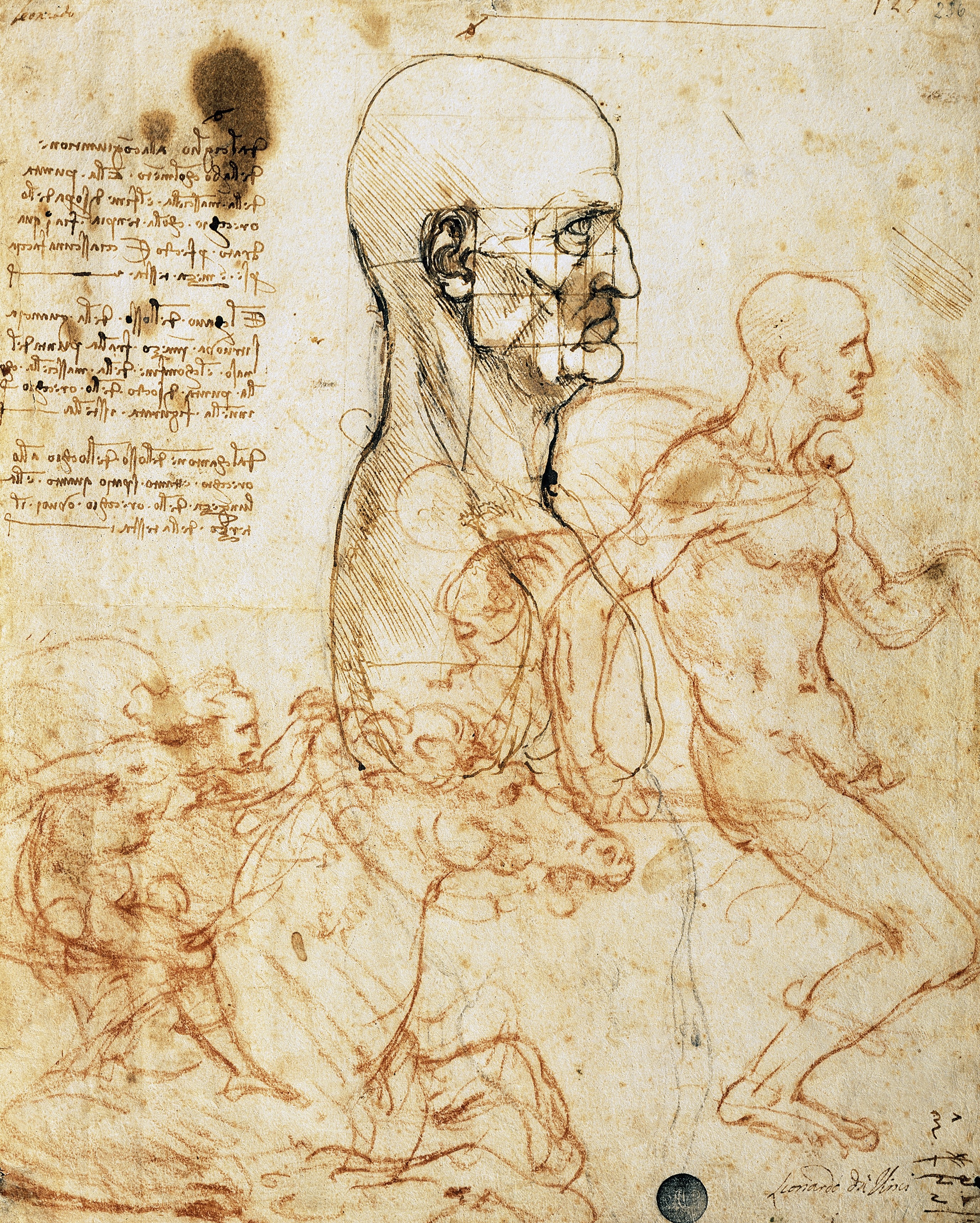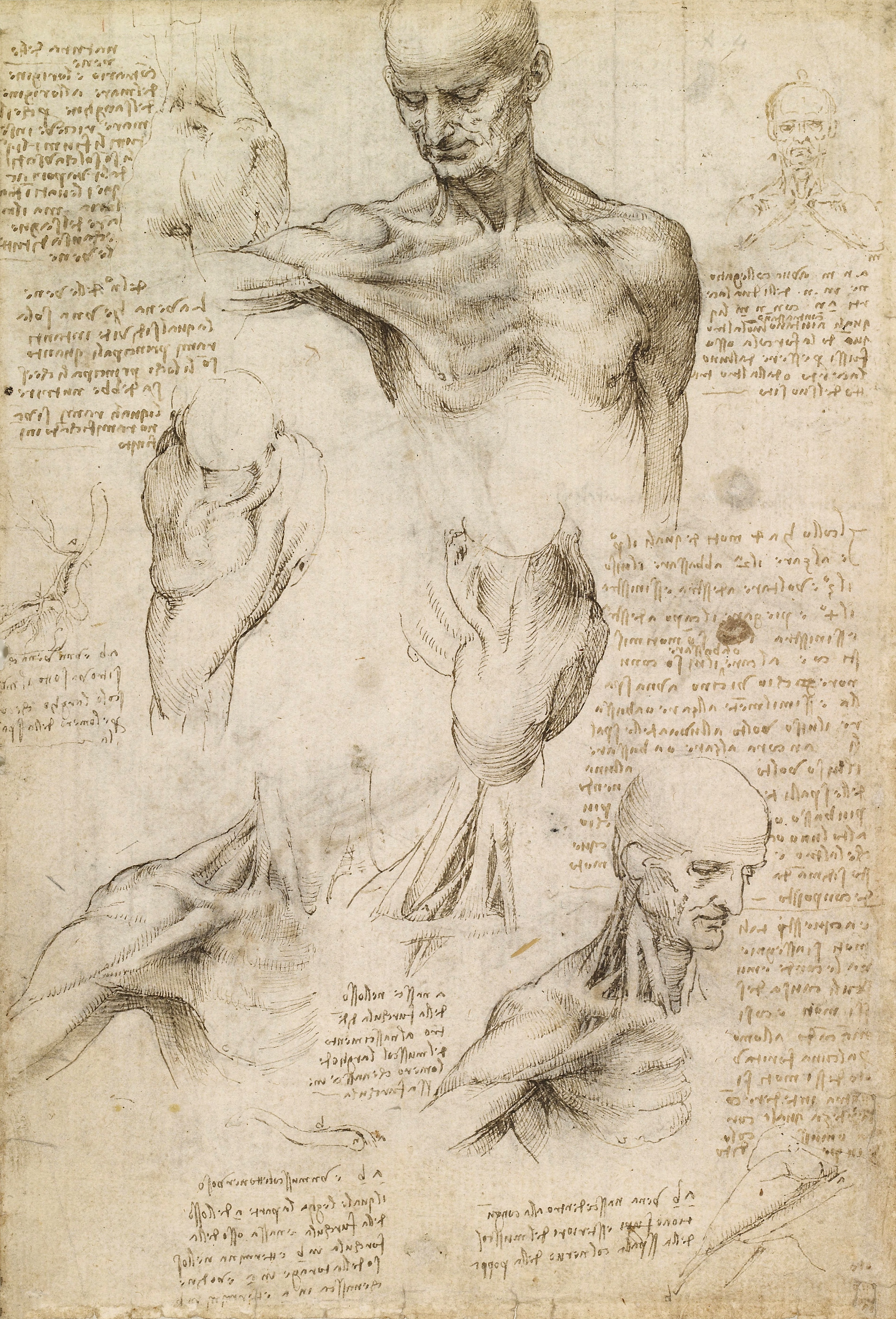Leonardo da Vinci
The Nature of the Human Body
Before dressing them, we first draw them nude
Image: Getty
Listen to this story
–:–
–:–
 Image: Getty
Image: Getty
As a young painter in Florence, Leonardo studied human anatomy primarily to improve his art. His forerunner as an artist-engineer, Leon Battista Alberti, had written that anatomical study was essential for an artist because properly depicting people and animals requires beginning with an understanding of their insides. ?Isolate each bone of the animal, on this add its muscles, then clothe all of it with its flesh,? he wrote in On Painting, which became a bible for Leonardo. ?Before dressing a man we first draw him nude, then we enfold him in draperies. So in painting the nude, we place first his bones and muscles which we then cover with flesh so that it is not difficult to understand where each muscle is beneath.?
Leonardo embraced the advice with an enthusiasm that any other artist, or for that matter most anatomists, would have found unimaginable. And in his notebooks he preached the same sermon: ?It is necessary for a painter to be a good anatomist, so that he may be able to design the naked parts of the human frame and know the anatomy of the sinews, nerves, bones, and muscles.? Following another part of Alberti?s creed, Leonardo wanted to know how psychological emotions led to physical motions. As a result, he would also become interested in the way the nervous system works and how optical impressions are processed.
The most basic anatomical knowledge for a painter is the understanding of muscles, and in this Florence?s artists were pioneers. Antonio del Pollaiuolo made an influential copperplate engraving of a battle scene of nude men, showing their muscles in more-than-full glory, around 1470, when Leonardo was associated with Verrocchio?s nearby workshop. Vasari wrote that Pollaiuolo ?dissected many bodies to study their anatomy,? though it?s likely these were merely surface studies. Leonardo, who probably observed some of these dissections, naturally soon became interested in exploring even more deeply, and he began what would be a lifelong association with Florence?s hospital of Santa Maria Nuova.
 Photo: GraphicaArtis/Getty Images
Photo: GraphicaArtis/Getty Images
When he moved to Milan, he discovered that the study of anatomy there was pursued primarily by medical scholars rather than by artists. The city?s culture was more intellectual than artistic, and the University of Pavia was a center for medical research. Prominent anatomical scholars were soon tutoring him, lending him books, and then teaching him dissection. Under their influence, he began pursuing anatomy as a scientific as well as an artistic endeavor. But he did not regard these as separate. In anatomy, as in so many of his studies, he saw the art and science as interwoven. Art required a deep understanding of anatomy, which in turn was aided by a profound appreciation for the beauty of nature. As with his study of the flight of birds, Leonardo went from seeking knowledge that could be of practical use and began seeking knowledge for its own sake, out of pure curiosity and joy.
This was evident when he sat down after seven years in Milan with a clean notebook sheet and made a list of the topics he wished to investigate. On top he wrote the date, ?on the second of April 1489,? which was unusual for him and an indication that he was embarking on an important endeavor. On the left-hand page he drew, with delicate strokes of a pen, two views of a human skull with veins. On the right-hand page, he listed topics to explore:
What nerve is the cause of the eye?s movement and makes the movement of one eye move the other?
Of closing the eyelid.
Of raising the eyebrows. . . .
Of parting the lips with teeth clenched. Of bringing the lips to a point.
Of laughing.
Of expressing wonder.
Set yourself to describe the beginning of man when he is created in the womb and why an infant of eight months does not live.
What sneezing is. What yawning is. Epilepsy.
Spasm.
Paralysis. . . .
Fatigue.
Hunger. Sleep. Thirst.
Sensuality. . . .
Of the nerve that causes the movement of the thigh.
And from the knee to the foot and from the ankle to the toes.
The list begins with inquiries, such as how eyes move and lips smile, that could be useful for his art. But by the time the list gets to an infant in a womb and the cause of sneezing, it is clear that he?s looking for more than information that might help his brush.
That intermingling of artistic and scientific interests is even more evident on another page that he began writing around the same time. With a sweeping scope, ranging from conception to mirth to music, that would have seemed audacious for anyone other than Leonardo, he outlined a treatise on anatomy that he hoped to produce:
This work should begin with the conception of man, and describe the nature of the womb and how the fetus lives in it, up to what stage it resides there, and in what way it quickens into life and gets food. Also its growth and what interval there is between one stage of growth and another. What forces it out from the body of the mother, and for what reasons it sometimes comes out of the mother?s womb before the due time. Then I will describe which parts grow more than the others after the baby is born, and determine the proportions of a child of one year. Then describe the fully grown man and woman, with their proportions, and the nature of their complexions, color, and physiognomy. Then how they are composed of veins, tendons, muscles and bones. Then, in four drawings, represent four universal conditions of men. That is, Mirth, with various acts of laughter, and describe the cause of laughter. Weeping in various aspects with its causes. Fighting, with various acts of killing; flight, fear, ferocity, boldness, murder and everything pertaining to such cases. Then represent Labor, with pulling, thrusting, carrying, stopping, supporting and such like things. Then perspective, concerning the functions and effects of the eye; and of hearing ? here I will speak of music ? and describe the other senses.
In subsequent notes he described how tissue, veins, muscles, and nerves should be shown from a variety of angles: ?Every part will be drawn, using all means of demonstrations, from three different points of view; for when you have seen a limb from the front, with any muscles, sinews, or veins which take their rise from the opposite side, the same limb will be shown to you in a side view or from behind, exactly as if you had that same limb in your hand and were turning it from side to side until you had acquired a full comprehension of all you wished to know.? Thus did Leonardo pioneer a new form of anatomical drawing, perhaps better described in his case as anatomical art, that is still in use today.
![]()
While studying Vitruvius for his work on the Milan and Pavia cathedrals, Leonardo became captivated by the ancient Roman architect?s detailed studies of human proportions and measurements. In addition, when he was measuring horses for the Sforza monument, he became interested in how they related to human proportions. Comparative anatomy appealed to his instinct for finding patterns across different subjects. So in 1490 he began measuring and drawing the proportions of the human body.
Using at least a dozen young men as models in his Corte Vecchia studios, he measured each body part from head to toe and produced more than forty drawings and six thousand words. His descriptions included both the average size of body parts and the proportional relationships between different parts. ?The space between the mouth and the base of the nose is one-seventh of the face,? he wrote. ?The space from the mouth to the bottom of the chin is one-fourth of the face and equal to the width of the mouth. The space from the chin to the base of the nose is one-third of the face and equal to the length of the nose and to the forehead.? These descriptions and others were accompanied by detailed drawings and diagrams with letters denoting the different measurements.
Page after page of his notebooks ? fifty-one sections in all ? are filled with ever more precise detail. His descriptions were inspired by Vitruvius, but they went far deeper and were based on his own observations. A small sample of his findings:
The distance from the top of the nose to the bottom of the chin is two-thirds of the face.?The width of the face is equal to the space between the mouth and the roots of the hair and is one-twelfth of the whole height.?From the top of the ear to the top of the head is equal to the distance from the bottom of the chin to the duct of the eye and also equal to the distance from the angle of the chin to that of the jaw.?The hollow of the cheek bone occurs half way between the tip of the nose and the top of the jaw bone.?The great toe is the sixth part of the foot, taking the measure in profile.?From the joint of one shoulder to the other is the length of two faces.?From the navel to the genitals is a face?s length.
I am tempted to quote him at even greater length because the enormity of his feat, and what it says about his compulsive mind, is evident not in each measurement but in the staggering accumulation of them. He goes on and on, relentlessly. In one entry alone there are at least eighty such calculations or proportions. It becomes both dazzling and dizzying. One tries to imagine him in his studio with measuring string and a handful of compliant assistants dutifully having every body part recorded. Such obsession is a component of genius.
Leonardo was not content merely to measure every aspect of every body part. In addition, he felt compelled to record what occurs when each of these parts moves. What happens to the relative shape of each human feature when a joint moves or a person twists? ?Observe how the position of the shoulder changes when the arm moves up and down, inwards and outwards, to the back and to the front, and also in circular movements and any others,? he instructs himself in his notebook. ?And do the same with reference to the neck, hands and feet and the breast.?
We can picture him in his studio, as he made his models move, turn, squat, sit, and lie down. ?When the arm is bent, the fleshy part shrinks to two-thirds of its length,? he recorded. ?When a man kneels down he will diminish by the fourth part of his height.?When a heel is raised, the tendon and ankle get closer to each other by a finger?s breadth.?When a man sits down, the distance from his seat to the top part of his head will be half of his height plus the thickness and length of the testicles.?
Plus the thickness and length of the testicles? Once again it is useful to pause and marvel. Why the obsessiveness? Why the need for reams of data? Partly, at least initially, it was to help him paint humans, or horses, in various poses and movements. But there was something grander involved. Leonardo had set for himself the most magnificent of all tasks for the mind of mankind: nothing less than knowing fully the measure of man and how he fits into the cosmos. In his notebook, he proclaimed his intention to fathom what he called ?universale misura del huomo,? the universal measure of man. It was the quest that defined Leonardo?s life, the one that tied together his art and his science.
3.3K
4
- Medicine
- History
- Art
- Science
- Biography
3.3Kclaps
3.3Kclaps
4 responses

Written by
Walter Isaacson
Follow
CEO of the Aspen Institute. Author of The Innovators & bios of Steve Jobs, Einstein, Ben Franklin, and Henry Kissinger. Former editor of Time, CEO of CNN
Follow![]()
Written by
Walter Isaacson
Follow


